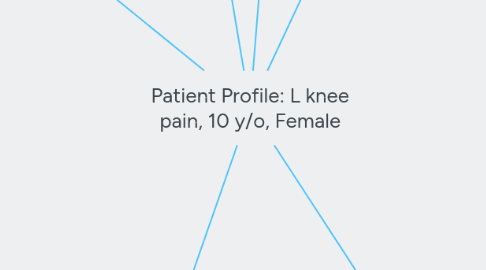
1. Subjective Findings
1.1. Function and ADLs
1.2. Pain
1.2.1. Medial
1.2.2. Lateral
1.2.3. Joint
1.2.4. Tibia
1.3. Recreation activities affected
2. Common Pediatric Knee Dx
2.1. Genu Varum (bow leg)
2.1.1. Spontaneous resolution in 95%w/ walking
2.1.2. Presentation: toeing in, bow leg
2.2. Tibial Torsion
2.2.1. Presentation: toeing in, IR of tibia
2.2.2. Normal rotation is 20 deg of ER
2.2.3. Treatment: resolves with growth, shoes and stretching not helpful, boots and bars are a common treatment but not good evidence in support
2.3. Blount' Disease
2.3.1. Growth of upper medial tibial epiphysis from abnormal pressure, presentation: varus
2.3.2. More common in African Americans and females
2.3.3. Treatment: bracing if needed, ostetomy last resort
2.3.4. Presentation: varus
2.4. Genu Valgum (knock knees)
2.4.1. Present 3-5 y/o, resolves by 7-8
2.4.2. Differential dx: asymmetric growth, metabolic disorders, skeletal dysplasia, congenitall abnormalities, neuromuscular disorders
2.4.3. Check patella alignment: patellar dislocation
2.4.3.1. Symptoms: rapid, acute swelling, pain and discoloration along site of injury
2.4.3.2. Exam: Q angle
2.4.3.3. Treatment: bracing
2.5. Osgood Schlatter Disease
2.5.1. Presentation: knee pain, pain w/ running and jumping, girls and boys about 8-14 y/o
2.5.2. Exam: tender over tibial tuberosity, tight RF
2.5.2.1. Palpation of tibial tuberosity
2.5.2.2. Thomas Test
2.5.3. Intervention: relative rest and activity modification, stretching of lower limbs
3. Clear the Hip
3.1. Developmental Hip Dysplasia DDH
3.1.1. History: first birth, female, breech position, left side
3.1.2. Exam: flat butt, dec abduction
3.2. Legg-Calves-Perthes Disease
3.2.1. Presentation: 4-10 y/o, M>F, limp and/or hip pain, intitially will refer to knee
3.2.2. Exam: dec hip IR, hip deformity
3.2.3. Treatment
3.2.3.1. Good prognosis: age less than 6 y/o at onset of sx, less than 50% head involvement, no stiffness or shortening on exam
3.2.3.2. Bad prognosis: age more 7 y/o at onset of sx, more than 50%, significant shortness and stiffness
3.2.4. Intervention Approaches
3.2.4.1. Containment of necrosis or fragmentation. Contain the femoral head deep in acetabulum until healing occurs-- bracing in abduction
3.2.4.2. Correction osteotomy
3.3. Slipped Capital Femoral Epiphysis
3.3.1. Presentation: limp and pain in hip or groin, medial knee, or thigh, M>F, 10-15 y/o, family history, obese children
3.3.2. Treatment: insertion of a single cannulated screw percutaneously under x-ray control
3.3.2.1. Post-op recovery is rapid, crutches foe 6 weeks
4. EXAMINATION:
4.1. Palpation: joint line, tibial tuberosity, patella, surrounding musculature
4.2. ROM: flexion, extension, valgus stress flexibility of HS and RF
4.3. Strength: clearing exam
4.4. Special Test
4.5. Alignment
5. History
5.1. Mechanism of Injury
5.2. Date of Onset
5.3. Type of onset
5.4. Family history
5.5. Sports/Recreational Activities
6. Objective Findings
6.1. ROM: expected to be hypermobile
6.2. Strength: hip flexion, knee extension and flexion, hip abduction, DF,and PF
6.3. Gait Assessment
6.3.1. Limp with medial knee pain
6.4. Posture: knee valgus or varus
6.5. Palpation
6.5.1. Tibial tuberosity
6.5.2. Patella
6.5.2.1. Patella tracking, tilt, laxity
7. Ligament Injuries
7.1. ACL
7.1.1. Mechanism of injury: rapid pivot, accelerating or decelerating suddenly, awkward landing, direct collision
7.1.2. Sports: basketball, soccer, football, and skiing
7.1.3. Presentation: pop is felt or heard, buckles, pain with swelling w/in hours, loss of full ROM, tenderness at joint line, and continued instability
7.1.4. Exam: Lachman test and pivot-shift test
7.1.5. Treatment
7.1.5.1. Conservative: HS strengthening, bracing for comfort
7.1.5.2. Surgical: especially for athletes, can be delayed in adolescents
7.1.5.2.1. Rehab begins quickly 1-2 days post-op, hinge knee brace for 4-6 weeks, full WB, and no open chain quad exercises
7.2. PCL
7.2.1. Mechanism of injury: direct blow to front of knee, twisting or hyperextension injury, misstep like in a hole
7.2.2. Presentation: pain wit swelling rapidly and quickly, stiff and limp, difficulty walking, "give out"
7.2.3. Exam: knee will sag into extension, posterior drawer test, and reverse pivot shift
7.2.4. Treatment: RICE, immobilization until swelling and pain are under control, PT- ROM and quad strengthening
7.3. Meniscus
7.3.1. Mechanism of injury: young- trauma or athletic event, over 40 y/o- degeneration of tissue
7.3.2. Presentation: knee pain when going down stairs or getting up from chair, stiffness and swelling, loss of ROM, locking or clicking, and knee locking
7.3.3. Exam: palpated tenderness on joint line, McMurray test, pain with squatting
7.3.4. Treatment
7.3.4.1. Conservative: small tears, RICE, crutches acute pain
7.3.4.2. Surgical: young pts are better candidates, partial- recovery within 2-3 weeks, and repair- NWB 2 wks, no squatting for 3 mo
7.4. MCL
7.4.1. Mechanism of injury: valgus overload, direct blow, and commonly associated with ACL
7.4.2. Presentation: pain and tenderness on the medial side of knee, feel "pop", swelling, and feeling of instability
7.4.3. Exam: instability with valgus stress at 30 deg
7.4.4. Treatment: RICE, Immobilization short-term, bracing for athletes, and PT- strengthening w/in allowed ROM
